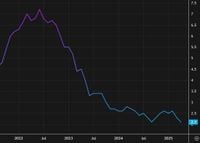On June 27, 2025, fresh data from the U.S. Commerce Department and other economic indicators painted a nuanced picture of the American economy, revealing both persistent inflationary pressures and signs of a potential slowdown in consumer spending and income. The latest Personal Consumption Expenditures (PCE) Price Index showed moderate inflation gains, while key measures such as shelter costs and personal income raised concerns about the economy's near-term trajectory.
The PCE Price Index, a critical gauge closely monitored by the Federal Reserve for its 2% inflation target, increased by 0.1% in May 2025, matching the rise seen in April and aligning with economists' consensus expectations. On a year-over-year basis, headline PCE inflation rose 2.3%, up slightly from 2.2% in April. When excluding the volatile food and energy sectors, core PCE inflation advanced 0.2% month-over-month, surpassing the 0.1% increase recorded in April. Annually, core inflation climbed to 2.7%, up from 2.6% the previous month.
This uptick in core inflation, while modest, was more robust than many analysts had predicted. According to a report analyzed on the same day, the Core Personal Consumption Expenditure Price Index recorded an actual reading of 0.2%, doubling the forecasted 0.1% increase and marking a 0.1% rise from the previous month. This higher-than-expected figure signals stronger consumer spending growth, which often bolsters the U.S. dollar and indicates underlying economic momentum.
However, the inflation story is only part of the economic narrative. Consumer income and spending data for March 2025, released alongside the inflation figures, showed troubling signs. Personal income fell by 0.4%, sharply missing expectations of a 0.3% increase and reversing a solid 0.8% gain from the prior month. Personal spending declined 0.1%, below the anticipated 0.1% rise and down from a 0.2% increase in February. Real personal spending, which adjusts for inflation, dropped 0.3%, a significant shift from the previous 0.1% gain.
These declines in income and spending suggest that despite inflationary pressures, consumers may be tightening their belts. Market reactions reflected this complexity: while the S&P 500 and Nasdaq Composite indexes hit record highs shortly after the PCE data release, yields on two-year U.S. Treasuries pared gains, indicating cautious investor sentiment amid growth concerns.
Experts weighed in on the implications. Oliver Pursche, Senior Vice President and Advisor at Wealthspire Advisors in Westport, Connecticut, emphasized that inflation remains a central concern for the Federal Reserve. "The big takeaway is inflation is going to continue to be a concern for the Fed and be a key driver in interest rate policy, so if anything it creates a little bit more doubt in whether the Fed will lower rates as early as July," he said.
Peter Cardillo, Chief Market Economist at Spartan Capital Securities in New York, expressed alarm over the disappointing income and spending figures. "Personal income is disappointing. We were looking for an increase of about 0.3%, so now it's negative. We were looking for a weak personal spending number, but again negative. These two indicators raise the possibility that the economy has slowed in the second quarter and may be headed for negative economic activity," Cardillo explained. He further noted that while inflation was largely in line with expectations, the core PCE reading was slightly higher than anticipated. "I think the real worry here is personal income and spending moving lower. All signs point to a weakening economy, with a possibility that the economy has already fallen into a technical recession," he warned.
Ian Lyngen, Head of U.S. Rates Strategy at BMO Capital Markets in New York, highlighted the surprising weakness in consumer spending. "Personal spending surprised on the downside at -0.1% month-over-month in May versus +0.2% prior and +0.1% expected. The Treasury market is taking direction from the consumption figures over the inflation data—a notable tone shift that implies growth concerns are mounting," he observed.
Adding another layer to the inflation story, shelter costs—a major component of consumer expenses—showed signs of easing but remain elevated. The Consumer Price Index (CPI) shelter component rose 3.9% year-over-year in May 2025, slightly down from 4.0% in April and significantly lower than the cycle peak of 8.2% recorded in March 2023. Similarly, the Personal Consumption Expenditures (PCE) measure of shelter inflation decreased to 4.1% year-over-year in May. Notably, asking rents have been mostly flat year-over-year, which suggests that these shelter inflation measures are likely to decline gradually over the coming months as rents for existing tenants continue to rise moderately.
On a three-month annualized basis, key inflation measures were comfortably below the Federal Reserve's 2% target, with Core PCE prices rising 1.7% and Core PCE excluding housing increasing 1.1%. These figures hint at some residual seasonality effects, especially evident in the first quarter, but also suggest a gradual easing in inflationary pressures.
Despite the mixed signals, the Federal Reserve maintained its benchmark overnight interest rate in the 4.25% to 4.50% range last week, a level it has held steady since December 2024. This cautious stance reflects the central bank's balancing act between curbing inflation and supporting economic growth amid emerging signs of slowing consumer activity.
Currency markets responded to the data as well. The USD/JPY exchange rate traded at 144.58 ahead of the report and dipped slightly to 144.44 afterward, reflecting investor recalibration in light of the mixed economic signals.
In sum, the latest economic data released on June 27, 2025, reveals a complex landscape. Inflation remains persistent, particularly in core measures, but consumer income and spending have softened, raising concerns about the economy's momentum. Shelter inflation is easing but still elevated, and the Federal Reserve faces continued uncertainty in setting its policy course. As experts caution about the risk of a technical recession, market participants will be watching closely to see how these conflicting signals shape the economic outlook in the months ahead.

